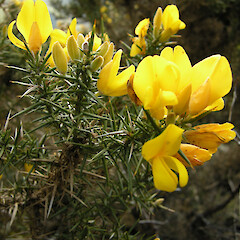Ulex europaeus
Common name
gorse
Family
Fabaceae
Flora category
Vascular – Exotic
Structural class
Trees & Shrubs - Dicotyledons
NVS code
The National Vegetation Survey (NVS) Databank is a physical archive and electronic databank containing records of over 94,000 vegetation survey plots - including data from over 19,000 permanent plots. NVS maintains a standard set of species code abbreviations that correspond to standard scientific plant names from the Ngä Tipu o Aotearoa - New Zealand Plants database.
ULEEUR
Conservation status
Not applicable
Habitat
Terrestrial. A plant of coastal and lowland habitats. The plant occurs in sites with low - low/modertate fertility. It is common in disturbed areas and can tolerate a wide range of conditions and soil types allowing it to establish in most areas. It is more abundant in waste places, riverbeds and poorer land than it is in developed and fertile land. It occurs in scrub and forest margin, shrubland, fernland and riverbed communities and grassland, shrubland, forest margins, coastal habitats and waste places. It occurs in rough foothills and less-intensively farmed areas and is often abundant in disturbed lowland and lower montane places. It is a plant that often aggressively invades rough pasture.
Wetland plant indicator status rating
Information derived from the revised national wetland plant list prepared to assist councils in delineating and monitoring wetlands (Clarkson et al., 2021 Manaaki Whenua – Landcare Research Contract Report LC3975 for Hawke’s Bay Regional Council). The national plant list categorises plants by the extent to which they are found in wetlands and not ‘drylands’. The indicator status ratings are OBL (obligate wetland), FACW (facultative wetland), FAC (facultative), FACU (facultative upland), and UPL (obligate upland). If you have suggestions for the Wetland Indicator Status Rating, please contact: [Enable JavaScript to view protected content]
FACU: Facultative Upland
Occasionally is a hydrophyte but usually occurs in uplands (non-wetlands).
Detailed description
Shrub up to 2m high; main stems erect or spreading, densely branched in younger parts but eventually bare at base; young twigs and spines somewhat glaucous; hairs usu. grey. Leaves of seedlings not spinous but with 3 hairy leaflets; spines branched; terminal and lateral spines rigid, deeply furrowed, 15~30mm long; secondary spines subtending lateral up to 12mm long. Flowers solitary; bracteoles acute to rounded, 1.5~3mm wide. Calyx greenish-yellow, about 2/3~3/4 length of corolla, with generally patent hairs; calyx teeth connivent. Corolla clear yellow or golden yellow, 13~20mm long; wings > keel. Pod villous, turning dark brown to black, 13~25mm long; seeds smooth and rounded, brown or greenish-brown, shiny, few per pod. (Webb et. al., 1988).
Similar taxa
A densely branched shrub with sharp spines, eventually bare at the base. The plant is up to 4 metres high and the leaves are very prickly. The stems and branchlets are green to brown in colour. The flowers are yellow and pea-like. The seeds occur in furry pods, are 13-25mm long and contain smooth, rounded, brown or greenish brown seeds. The pod explodes loudly on warm days. The pods are green that turn dark brown to black.
Flowering
(January) May, June, July, August, September, October, November (December)
Flower colours
Yellow
Life cycle
Perennial. The flowers are monoecious. Seeds germinate in spring or autumn or spring to mid-summer. Reproduces vegetatively. Seed is produced at a rate of 500 - 1 000/m sq/annum and can remain viable for up to 100 years but significant amounts do not last beyond 30 years. Seeds germinate best at temperatures of 15 to 19 degrees celcius (Parsons and Cuthbertson, 2001). Seed is dispersed by an explosive mechanism and gravity. Seed pods disperse seed up to 6 metres from the parent plant. Machinery assists seed dispersal. Some seed is carried by water and shingle and by gravel, soil and birds.
Year naturalised
1867
Origin
Western Europe
Reason for introduction
Ornamental
Tolerances
The plant is tolerant to frost and drought; intolerant to shade and slightly tolerant of poor drainage.
Notes on regeneration
It resprouts from sub-epidermal and axillary buds after grazing. It resprouts from a well-developed lignotuber and seed dormancy is broken by fire. Burning gorse provides an ideal seed bed. The plant needs full light to grow well and cannot regenerate under its own shade (Wilson & Galloway 1993). It requires low to medium soil fertility (Atkinson 1997).


















